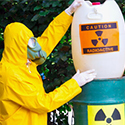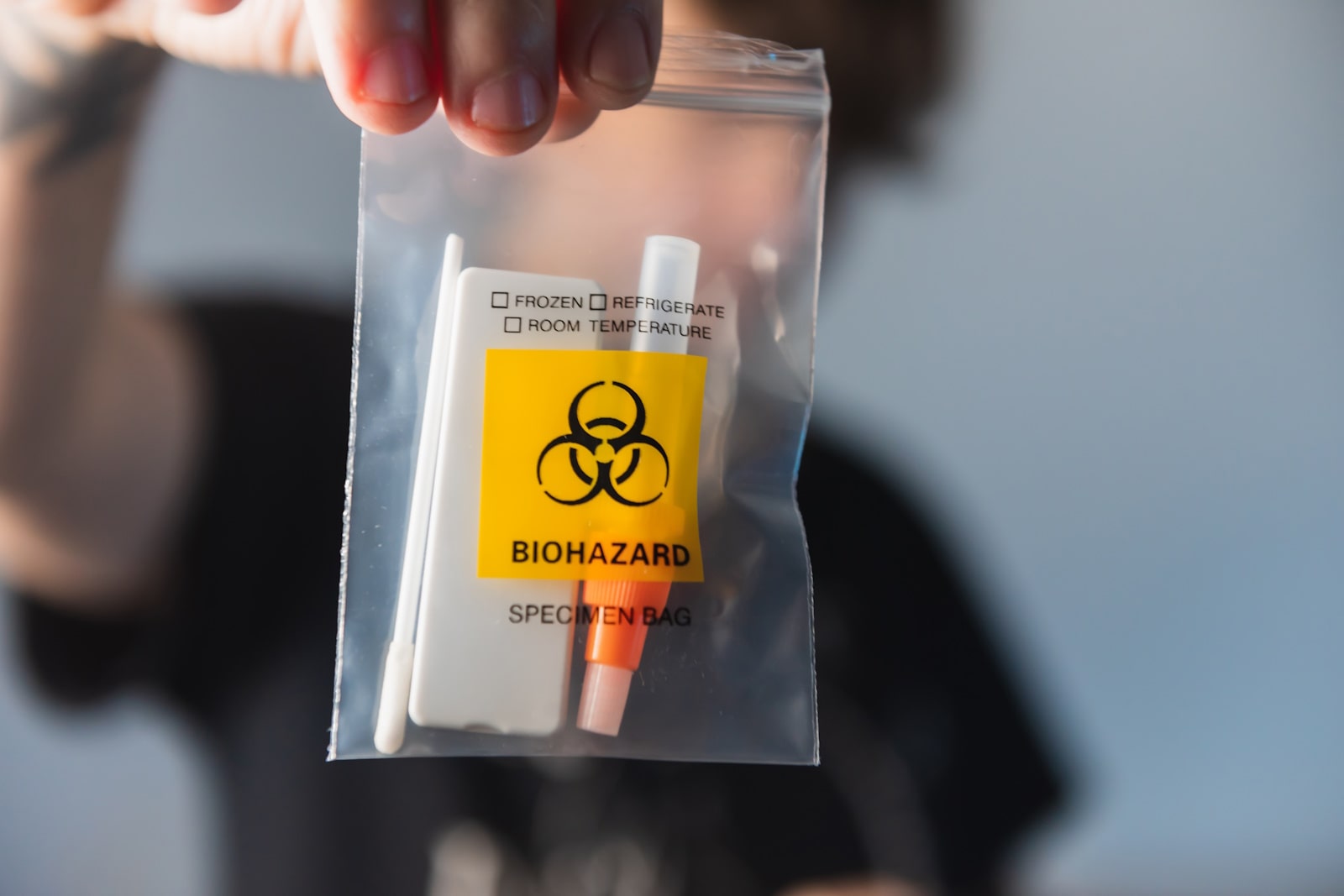Radioactive Materials in Medical Disposal Waste
Radioactive materials are fundamental in modern healthcare, from cancer treatment to diagnostic imaging. However, the disposal and management of radioactive medical disposal waste remain complex and highly regulated processes. Without effective protocols, such waste poses risks to healthcare workers, the public, and the environment. Facilities handling radioactive materials must implement strict procedures to manage these waste streams safely and sustainably while ensuring compliance with national and international standards.
Types of Radioactive Medical Waste
Radioactive medical disposal waste is categorised by its source and nature. Radiopharmaceutical waste results from diagnostic and therapeutic applications such as iodine-131 used in thyroid treatments or technetium-99m in nuclear imaging. Sealed sources, including brachytherapy implants and blood irradiators, are another significant category, often encapsulated in stainless steel to contain radioactivity. Additionally, contaminated materials such as gloves, lab coats, absorbent pads, and syringes that come into contact with radioactive substances during patient care or laboratory preparation are classified as radioactive waste. Each waste type requires specific segregation and disposal to ensure safety and compliance.
The management of medical disposal waste begins with accurate identification of its type to prevent mishandling and environmental contamination. Radiopharmaceutical residues can emit gamma radiation, sealed sources pose long-term hazard if damaged or unshielded, and contaminated consumables, while lower in radioactivity, still require secure packaging and disposal. This initial categorisation ensures that disposal pathways align with waste characteristics, mitigating exposure risks for staff and the public.
Classification of Radioactive Waste Levels
Radioactive medical disposal waste is classified into different levels to determine appropriate handling and disposal methods. Very low-level waste (VLLW), also termed exempt waste, has minimal radioactivity and, after decay-in-storage, can often be disposed of as general waste. Low-level waste (LLW) encompasses the majority of medical disposal waste, including contaminated gloves, syringes, and other consumables that require shielding and regulated disposal. Intermediate-level waste (ILW) includes waste with higher radioactivity, such as certain sealed sources or dense shielding materials, requiring engineered containment.
Although high-level waste (HLW) is rare in medical facilities, its management is critical where it occurs, such as in certain research settings involving spent nuclear fuel. HLW requires deep geological repositories for isolation from the environment. Differentiating waste classes ensures each type of medical disposal waste is disposed of appropriately, minimising radiological hazards while complying with South African National Nuclear Regulator (NNR) standards and international safety frameworks.
Decay-in-Storage Method
Decay-in-storage is a widely used approach to manage short-lived radioactive medical disposal waste cost-effectively and safely. Facilities store waste containing isotopes with relatively short half-lives in shielded storage areas until the radioactivity decays to background levels. For example, iodine-131 with an eight-day half-life is typically stored for at least 80 days before disposal with general waste, eliminating the need for specialised external disposal services for this category of waste.
The decay-in-storage method also applies to liquid waste from patients undergoing radiopharmaceutical treatments, managed via delay tanks. Wastewater is retained until its radioactivity decreases to levels permitted for sewer discharge under South African Hazardous Substances Act regulations. This approach reduces operational costs and logistical burdens while protecting staff and the environment from unnecessary exposure, making it a vital strategy in medical disposal waste management programmes.
Packaging and Labelling Requirements
Stringent packaging and labelling requirements apply to all radioactive medical disposal waste. Waste must be packaged in durable, leak-proof, and radiation-shielded containers to prevent accidental release during storage, handling, or transport. Containers are clearly labelled with radionuclide identity, activity levels, hazard warnings, and the date of sealing, ensuring all stakeholders are aware of the risks associated with the waste.
Proper labelling is not merely a compliance exercise but a critical safety measure. It enables waste handlers, transporters, and disposal facility personnel to adopt correct handling procedures, minimising risks of exposure or environmental contamination. South African regulations, aligned with International Atomic Energy Agency (IAEA) standards, mandate detailed labelling to ensure consistent management of medical disposal waste across facilities nationwide.
Transportation of Radioactive Waste
When decay-in-storage is not practical or permitted, medical disposal waste must be transported to licensed disposal facilities. In South Africa, transportation adheres to the Hazardous Substances Act and the National Nuclear Regulator’s regulations, requiring robust containment, comprehensive labelling with hazard placards, and transport documentation outlining the waste’s nature, quantity, and handling requirements. Vehicles and drivers must be certified for hazardous material transport.
Transportation protocols are designed to protect public health during off-site transfer. International guidelines under the IAEA set stringent container integrity standards and route planning requirements to reduce accident risk. This ensures radioactive medical disposal waste is safely moved for processing or disposal without harming the environment or communities along the transit route.
Regulatory Bodies and Guidelines
Regulatory oversight of radioactive medical disposal waste ensures safety and environmental protection. The International Atomic Energy Agency establishes global standards for waste classification, handling, and disposal. In South Africa, the National Nuclear Regulator governs licensing, facility operation, and waste management compliance, while the Department of Health’s Directorate: Radiation Control enforces facility-level safety standards under the Hazardous Substances Act.
These regulatory bodies work to ensure that facilities handling medical disposal waste implement best practices, including proper waste segregation, decay-in-storage protocols, and safe transport and disposal. Their guidelines also cover training, emergency preparedness, and environmental monitoring to protect workers and surrounding communities.
Personal Protective Equipment (PPE) in Handling
Personal protective equipment is vital in protecting staff handling radioactive medical disposal waste. Required PPE includes laboratory coats, gloves, safety goggles, face shields, and dosimeters to monitor cumulative radiation exposure. Facilities also implement strict time, distance, and shielding principles to minimise exposure risks during routine operations and emergency interventions.
Effective PPE usage is complemented by clear protocols on contamination control, hand hygiene, and PPE disposal to prevent secondary contamination. Staff training programmes ensure that personnel remain confident and competent in using protective equipment, further strengthening the safety framework of medical disposal waste management.
Environmental Impact of Radioactive Medical Waste
Improper disposal of radioactive medical disposal waste can have serious environmental consequences. Radioactive contamination of soil, groundwater, and ecosystems poses long-term health risks to humans and wildlife. For example, leachate from inadequately contained waste can spread radioactivity beyond the disposal site, while incineration without proper filtration systems risks atmospheric contamination.
Environmental monitoring is crucial to identify potential contamination early and implement remedial measures. Facilities must design waste management systems that incorporate engineered barriers, sealed containers, and licensed disposal routes to protect the environment and public health, meeting both national and international standards for radioactive waste management.
Radioactive Waste Disposal Facilities
Disposal facilities for radioactive medical disposal waste are engineered to prevent environmental contamination over long periods. Low-level and intermediate-level waste is disposed of in specially designed landfills with multiple containment layers and leachate control systems. High-level waste, although rare in healthcare, requires deep geological repositories capable of isolating radioactivity for thousands of years.
In South Africa, disposal facilities are regulated by the National Nuclear Regulator to ensure their design and operational standards protect workers, the public, and the environment. Effective waste tracking and container integrity checks are implemented at these facilities to maintain accountability from waste generation to final disposal.
Training Requirements for Staff
Training is fundamental to safe radioactive medical disposal waste management. Personnel handling waste must complete formal courses covering radiation physics, safe handling procedures, PPE use, emergency response, and regulatory requirements. Practical training on contamination control and waste packaging ensures operational readiness and compliance.
Ongoing refresher training keeps staff updated with evolving technologies and regulations. This continuous learning culture enhances institutional safety standards, reduces incident rates, and ensures all aspects of medical disposal waste management are carried out safely and efficiently.
Emergency Response Procedures
Emergency preparedness is critical when handling radioactive medical disposal waste. Facilities must have documented response plans for leaks, spills, or exposure incidents, including immediate containment, area evacuation, radiation surveys, decontamination, and medical assessments. Clear communication protocols ensure swift notification of radiation protection officers and the National Nuclear Regulator.
Regular emergency drills test readiness, build staff confidence, and identify areas for improvement. Effective emergency management protects personnel, patients, and the public from radiological hazards while ensuring swift recovery of normal operations.
Cost and Logistical Challenges
Managing radioactive medical disposal waste involves significant cost and logistical complexities. Expenses include decay-in-storage infrastructure, compliant packaging, specialist transport services, staff training, and rigorous record keeping. For facilities in resource-limited settings, these requirements can strain operational budgets, making outsourced waste management a viable solution.
Strategic planning and partnerships with licensed providers such as A-Thermal can streamline waste management processes, ensure compliance, and minimise operational disruptions. Investing in efficient waste management infrastructure is vital to maintaining patient safety and institutional reputation.
Record Keeping and Inventory Control
Effective record keeping is a cornerstone of compliant radioactive medical disposal waste management. Facilities must maintain up-to-date inventories of radionuclides, decay logs, disposal manifests, and transport certificates. This documentation ensures traceability of each waste item from generation to disposal, demonstrating compliance with regulatory standards.
Accurate records also support audits, incident investigations, and waste minimisation initiatives by providing data for informed decision-making. Implementing digital tracking systems can enhance record accuracy and accessibility, strengthening regulatory compliance and operational efficiency.
Public Health and Safety Considerations
The ultimate goal of radioactive medical disposal waste management is to protect public health and safety. Facilities must conduct community risk assessments, maintain environmental monitoring programmes, and communicate transparently with stakeholders about safety measures. Protecting local communities from exposure builds trust and ensures social licence to operate.
Public health considerations also influence waste management design, transportation planning, and emergency preparedness, ensuring every stage of medical disposal waste handling prioritises community well-being.
Future Innovations in Radioactive Waste Treatment
Innovations in radioactive medical disposal waste treatment are shaping safer and more sustainable healthcare. Transmutation technologies, advanced decay accelerators, and non-radioactive alternatives like x-ray blood irradiators are reducing waste volume and hazard levels. These technologies minimise the need for long-term disposal and simplify regulatory compliance.
As global healthcare demands increase, investment in such innovations will become critical to maintaining safe, compliant, and cost-effective radioactive waste management systems that support both environmental stewardship and patient care.
Safe handling and disposal of radioactive medical disposal waste are essential to protect patients, staff, and the environment. We at A-Thermal are dedicated to providing compliant, reliable, and efficient waste management solutions tailored to your facility’s needs. Contact us today to learn how we can support your medical disposal waste requirements with confidence and expertise.







